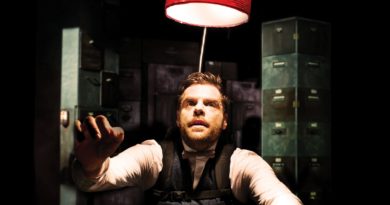People, Places & Things at Bristol Old Vic.
Some reviews are difficult to write, and this is one of them. Not because I didn’t enjoy Headlong Theatre’s co-production with National Theatre, HOME and Exeter Northcott of People, Places & Things which I saw at Bristol Old Vic on Wednesday; the exact opposite in fact. This show is one of the best, most nuanced pieces of theatre I’ve seen in a very long time, and my difficulty lies in ensuring I use the right tone and words to do justice to this excellent piece of theatre. Another reason I find this difficult to review is because it touches me very personally; I grew up with a father who was an alcoholic and who spent many stints in and out of rehab. His recovery was not successful, so I know first hand that the path of recovering from addiction is not always a linear one with a happy ending. I know how difficult it is to live with an addict, how angry it can make you and how painful it is to see them put the substances they crave above you. I was concerned that this show which deals with addiction and recovery could potentially be riddled with cliché and would not represent my experiences. However, the piece seems very much like someone who knows held it reverently. I sense writer Duncan Macmillan must have had personal experience of the subject. If he hasn’t, then it just makes the writing even more extraordinary.
Emma (played by Lisa Dwyer-Hogg) is an actress and spends so much of her time pretending to be other people that she find the only way she can comfortably be herself is to numb reality with a cocktail of alcohol and drugs. As the show opens, Emma is landing in rehab with a sense of ambivalence. It is clear she knows she needs to be there, but she rages hard against the treatment and sabotages her chances of recovery with her inability to be truthful. At first, the character of Emma perfectly represents the addictive personality I recognise. She is unlikeable, self absorbed, unpredictable and chaotic. We watch as she takes herself apart in order to put herself back together, and as I joined her in the process I developed empathy for this vulnerable, grieving, lost young woman. The show also identifies an uncomfortable truth; in these difficult times we are living in with the rise of the far right, with climate change risking the future of the planet, with everything seemingly going to hell in a hand basket, what level of moral ambivalence would you need in order to inhabit this world without some level of self medication to take the edge off? The title of the show is a reference to all the things and situations an addict will need to avoid in order to safeguard their recovery and reduce the risk of relapse once back in the ‘real’ world. But, as is highlighted during a group therapy session Emma is part of, what happens if absolutely everything would prove to be a trigger? How many of us can honestly say that we have never used alcohol or drugs to escape a bad week, to take the edge off social situations or to simply enhance our experience? How many of us could tolerate a social situation in a bar without a drink in our hands, even those of us who wouldn’t identify as ‘addict’?
I loved everything about this piece of theatre, even if it made for uncomfortable viewing. As I have mentioned, the writing is just brilliant and the subject is explored in a thought provoking and intelligent way. The staging is powerful, and the direction from Jeremy Herrin with Holly Race Roughan is exceptional. The ever present Exit sign at the back of the stage is a clear metaphor for the fact that the addict is free to leave the process at any time, but painfully tempting as this is it might not be the wisest choice. The idea of having an audience also sat at the back of the stage facing out is extremely clever. I discussed it with my companion, and it took us a while to decide if the people watching Emma were part of the ensemble or fellow theatregoers. It was only a tweet I saw later from one of this audience that confirmed for me that they were not actors. This element of playing with the ‘forth wall’ without completely breaking it was a brilliant nod to the fact that Emma lives in a world where she often has an audience, and probably feels at her most comfortable putting on a performance. It’s a skill to be able to become another person so completely on stage, but she employs all her skills in rehab to be somebody else rather than fully engage with the painful process.
Perhaps I loved People, Places & Things so much because it resonated with my own personal experiences of supporting a loved one through rehab, so it is hard to be completely unbiased. However, my husband also thought this was a great piece of theatre, and we haven’t stopped thinking about it since. I urge you to see it if you can, it runs until Saturday 28th October at the Bristol Old Vic. Be prepared to confront some difficult feelings though; amazingly I felt like pushing the self destruct button after this and going on a massive bender despite seeing this young woman fall apart on the stage in front of me. I may be the daughter of an addict, but I’m also in touch with my addictive personality. If any of my words have resonated with you, then perhaps consider volunteering to be the designated driver for the evening before you head out…
Review by Karen Blake
Photo credit: People, Places & Things – Photo by Johan Persson





